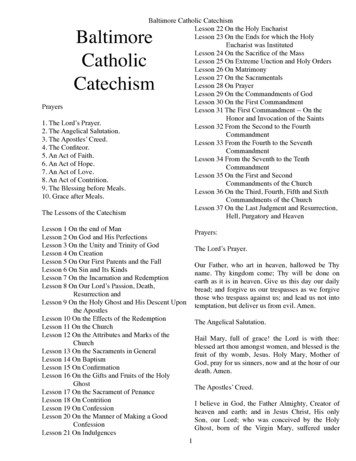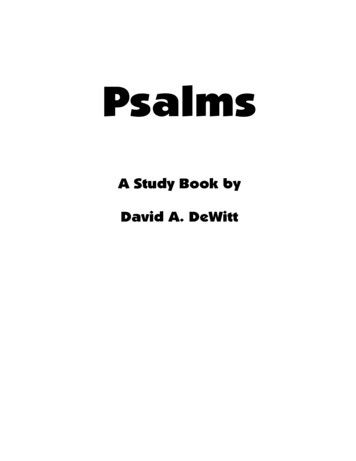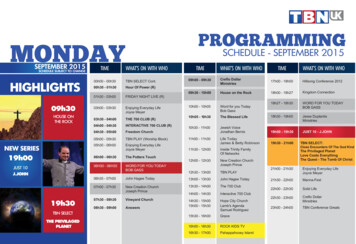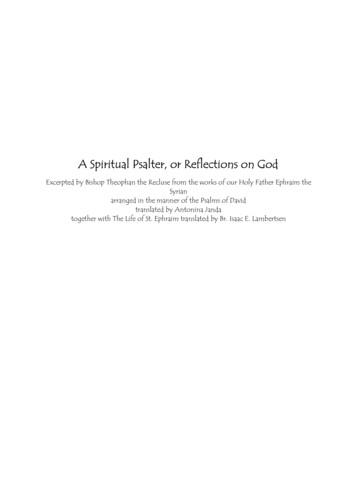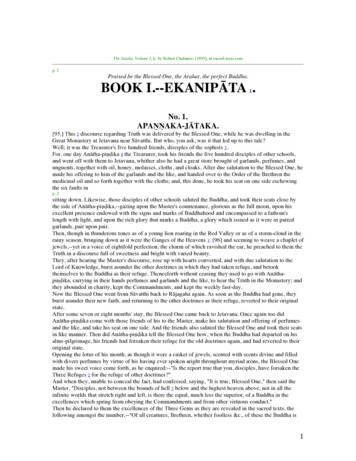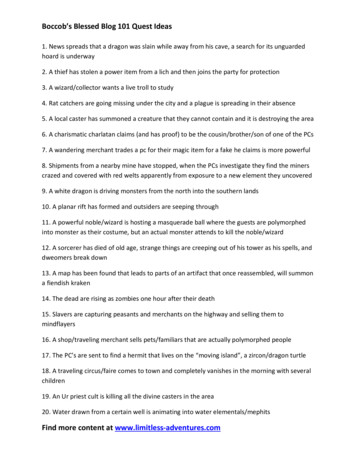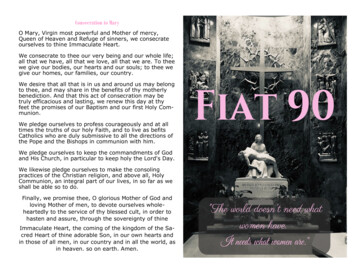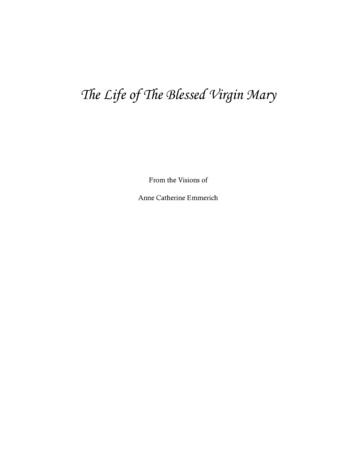
Transcription
The Life of The Blessed Virgin MaryFrom the Visions ofAnne Catherine Emmerich
Translated by: Sir Michael PalairetTranslator’s Note: I have omitted some of Clemens Brentano’s notes altogether and havetranslated only extracts of some of the others; but have included everything that seemedlikely to interest the English reader.Supplementary notes by the translator, Sir Michael Palairet, are indicated with (Tr)Supplementary notes by Rev. Sebastian Bullough, O.P. are indicated with (SB)Supplementary notes by Clemens Brentano are indicated with (CB)Supplementary notes by Ronald L. Conte Jr. are indicated with (RC)Note: Anne Catherine Emmerich was born on September 8th, 1774, at Flamske, nearKoesfeld, Westphalia, West Germany, and became on November 13th, 1803, a nun of theAugustinian Order at the Convent of Agnetenberg at Dülmen (also in Westphalia). She diedon February 9th, 1824. Full details of her life and death will be found in the preface to TheDolorous Passion of Our Lord Jesus Christ.2
Extract From The Preface To The German Edition:Most readers of The Dolorous Passion of Our Lord Jesus Christ according to the visions of thedevout Anne Catherine Emmerich are no doubt aware that this book contains only a part ofthose visions. Clemens Brentano spent several years in Dülmen in the endeavour toreproduce with scrupulous care the visionary’s utterances, which were sometimesfragmentary and sometimes formed a connected narrative. This was the origin of his diary,which was begun in January 1820 and contained a great variety of visions regarding thelives of the Saints, the feasts of the Church and other events. Later, however, in the years1821 and 1822, these visions became more and more concentrated on the Life of Christ andof the holy persons about Him. The records of these visions, which still exist in their originalform, were made by the late Clemens Brentano with almost documentary precision. Heextracted from them everything relating to the Life of Christ, and was thus able to present tothe reader the public Life of Our Lord day by day according to Catherine Emmerich’svisions. The last portion of these records has been printed under the title of The DolorousPassion of Our Lord.Besides this large collection of accounts of the Life of Christ, Clemens Brentanocompleted another smaller one relating to the life of the Blessed Virgin. After arranging therelevant extracts and choosing wood-cuts to illustrate them, he started printing them in1841, and had finished a considerable part when a lingering illness put a stop to his workand finally caused his death on July 28th, 1842. After this sad event his papers, includingthose relating to Catherine Emmerich, came into the hands of his brother ChristianBrentano in Aschaffenburg. The latter died on October 27th, 1851, without having carriedout his intention of continuing to print the Life of Our Lady; but fortunately his widow wasable, with the help of some learned friends, to complete the work.When the Dolorous Passion appeared, Catherine Emmerich’s visions were known only toa few, though very distinguished men. In the meantime the voices of many thousands ofreaders have swelled the originally very modest applause. However the historical ortheological character of the work may be judged, it is acknowledged to be a treasury of holyscenes and pictures which contribute to the edification and inspiration of the faithful. In thisrespect the Life of Mary is, we consider, a worthy companion to the Dolorous Passion. It doesnot, however, like the latter, present a complete and comprehensive narrative. The gapswhich occur in it are to be explained by its close connection with the Life of Christ. Since thelatter was necessarily often concerned with the Virgin Mother, sections of the Life of Maryhad to be omitted in order to avoid repetitions when the Life of Christ should be printed (as itwas later). The latter work should therefore be read in conjunction with the Life of Mary.11Currently these books are titled: The Dolorous Passion of Our Lord Jesus Christ, The Life of the Blessed Virgin Mary,and The Life of Jesus Christ and Biblical Revelations. The latter title was published in 1914 as: The Lowly Life andBitter Passion of Our Lord Jesus Christ and His Blessed Mother together with the Mysteries of the Old Testament.3
Observations On The Supplementary Notes:Those who read or even merely look at this book must perforce ask themselves to whatextent the statements of Anne Catherine Emmerich are consonant with what can be knownof the persons, places, and events in question through the channels of inspired Scripture,reliable history, legitimate tradition, and established geography. Clemens Brentano set outto meet this inquiry as far as he could with the materials and evidence that were available tohim at the time. His notes (as completed by his brother) have been preserved, and are herefollowed by his initials CB in parentheses. A further series of notes has been prepared forthis edition, sometimes annotating the text directly, and sometimes elucidating the notes ofBrentano. These are indicated by the initials SB in parentheses. Attention has been paidthroughout to the witness of the four channels of information mentioned above, either tocorroborate the statements or to indicate that there is no supporting evidence, or to suggestthat there has been some confusion of facts, or occasionally to correct some detail (usuallyof a chronological, geographical, or philological nature) which appears to be mistaken.These notes have not been concerned with the problem of the immediate provenance ofthe material and the relationship of the visionary to Brentano and any other sources whichhe may or may not have used. Nor are they concerned with the nature or origin of thevisions. Their only object has been to test the accuracy of the material as it stands.It is wise to be aware throughout of what Scripture relates about the events described,and to this end the Scriptural reference has been inserted in a note to each chapter-heading.Similarly, when a Biblical character or event appears, a reference is given except in the mostobvious cases. Old Testament legislation is also referred to, when a point of ritual is raised,supplemented by Rabbinic rulings which were current at the time of Christ, and which arepreserved in the Mishnah. In all these matters, it may be said at once that the statements ofAnne Catherine Emmerich (always written AC in the Supplementary Notes) are neverfound to be counter to the Scriptures, nor mistaken about Jewish ritual at the time, as far asthis is ascertainable, apart from a small point about the calendar. When AC’s statementsinvolve a particular interpretation of a Biblical text, this is noted. The Biblical references ofClemens Brentano (always referred to as CB) have all been checked, and they have alwaysbeen found correct, though occasionally in need of supplement. His Rabbinic references,similarly, have sometimes required expansion.The contemporary historian Josephus (A.D. 37-c. 100) is an indispensable source for theperiod. His main works, The Antiquities of the Jews and The Wars of the Jews, are referred to bytheir usual abbreviations Ant. and Wars. The Mishnah is quoted by tractate and section. CB’sreferences to other authors have also been checked, and sometimes more exact referenceshave been provided. His philological observations have usually been simply supplementedby additional notes, confirming or correcting according to more recent studies. It may besaid that CB’s findings, especially in the field of Scripture and history, have in most casesbeen found reliable, and his annotations, especially in view of his confessed lack of trainingand equipment, deserve the highest commendation.Many early Christian traditions were preserved in the so-called apocryphal gospels.These documents, while plainly composed not as serious histories but as edifying or even4
diverting imaginations, usually under the pseudonym of some Biblical person (being morelike pious ‘historical novels’ of the time), do in all probability enshrine many historical factssubsequently adorned with fancies of a later age. When a parallel can be traced betweenAC’s statements and these traditional sources, the matter is duly noted, and it is interestingto observe how rarely AC’s account shares the fanciful elaborations of the apocryphalmaterial. Furthermore, her frequent descriptions of people’s appearance and attire seemusually to be of an entirely independent nature. It is worth remembering in this connectionthat AC was at one time a professional seamstress, a fact which adds interest to her minuteobservation of clothes. Most of her intricate genealogical statements, so remarkablyconsistent throughout, find no parallels in the apocryphal literature. The documents referredto most frequently in the notes are the so-called Protevangelion of James (Protev.), PseudoMatthew (Ps-Matt.), and the Nativity of Mary (Nat. Mar.), with references to chapters. Theeditions used were The Apocryphal New Testament, translated by M. R. James (1924), and TheApocryphal Gospels, translated by J. Harris Cowper (1897). These editions made use of manytexts hardly available to CB.For exegetical work on the Bible, an invaluable aid has been the large CatholicCommentary published in 1953, where the general findings of modern scholarship have beenmade readily available and reliably presented. The references are to paragraphs.The geographical side presented many problems, and here the same Catholic Commentarywas of great assistance in the identification of Biblical sites, and the maps it includes are theresult of the latest geographical surveys of the Holy Land.For the conclusions of modern hagiography The Book of Saints (4th ed.), produced by themonks of Ramsgate in 1947, has been a handy work of reference. The Catholic Encyclopedia(1912) and the Jewish Encyclopedia (1905) have often given valuable assistance and guidanceto sources.Lastly, one cannot fail to mention the monumental work of Kaplan Helmut Fahsel, DerWandel Jesu in der Welt, nach den Visionen der Anna Katharina Emmerich, Basel, 1942, which isby far the most elaborate work on the subject, and whose maps and genealogies have beenconsistently useful.SEBASTIAN BULLOUGH, O.P.CambridgeIn festo SS. Nominis Mariae, 19535
I. OUR LADY’ S ANCESTORSLast night there came again before my soul everything that I had so often seen as a childconcerning the life of the ancestors of the Blessed Virgin Mary. I saw it all in a series ofpictures just as I did then. If only I could tell it all as I know it and have it before my eyes, itwould certainly give great joy to the Pilgrim.2 In my miserable state I was greatly revived bycontemplating these pictures. As a child I was so certain of all I saw that if anyone told meany of the stories differently, I would say straight out: ‘No, this is how it is.’ And, indeed, Iwould have let myself be killed rather than deny that it was thus and not otherwise. Lateron, life in the world confused me, and I kept silence. The inner certainty has, however,always remained with me, and last night I once more saw everything even to the smallestdetails.When I was a child, my thoughts were always taken up with the Crib and the Child Jesusand with the Mother of God, and I often wondered very much why people told me nothingabout the family of Our Lady. I could not understand at all why so little had been writtendown about her ancestors and relations. In the great longing which I had, I then received amultitude of visions of the Blessed Virgin’s ancestors. I must have seen them back to thefourth or fifth generation. I saw them always as wonderfully pious and simple peopleinspired by a quite extraordinary secret longing for the coming of the promised Messias. Isaw them always living amongst other men who, compared to them, seemed to me roughand barbarous. They themselves, I saw, were so quiet, gentle and kindly, that I often said tomyself in great anxiety about them: ‘Oh where can these good people find a refuge, how arethey to escape from those rough, wicked men? I will seek them out and will be their servant,I will fly with them into a wood where they can hide themselves; I am sure I shall still beable to find them!’ So clearly did I see them and believe in them, that I was always afraidand full of anxiety about them.I always saw these people leading a life of great self-denial. I often saw that those amongthem who were married bound themselves mutually to observe continence for a time; andthis gave me much joy, though why this was I could not clearly say. They practised theseseparations chiefly when they were occupied with all kinds of religious ceremonies,accompanied by incense and prayers.3 From these I perceived that there were priests amongthem. I often saw them moving from one place to another, leaving large homesteads andretiring to smaller ones, in order to lead their lives undisturbed by wicked people.They were so devout and so full of longing towards God that I often saw them, alone inthe field by day and by night too, running about and crying to God with such intense desirethat, in the hunger of their hearts, they tore open their garments at their breasts, as if Godwere about to burn Himself into their hearts with the hot rays of the sun, or to quench withthe moonlight and starlight their thirst for the fulfilment of the Promise.2The ‘Pilgrim’ is Clemens Brentano, who wrote down the visions at Catherine Emmerich’s dictation. Thesewere communicated by her to him on the morning of June 27th, 1819. (Tr.)3It is commonly stated that such separation was required of priests on duty, and this can be deduced fromLev.15.18 (ceremonial uncleanness contracted) and Lev. 22.3 (ceremonial cleanness required). (SB)6
Pictures like these came to me, I remember, when as a child or as a young girl I waskneeling and praying to God, alone with the flock in the pastures, or at night on the highfields above our farm; or when, in Advent, I walked through the snow at midnight to theRorate devotions in St. James’ Church at Koesfeld, three-quarters of an hour away from ourcottage at Flamske. The evening before, and in the night too, I prayed much for the poorsouls in purgatory. I thought that in their lives they had perhaps not been eager enough forgrace; perhaps they had given way to other desires for the creatures and goods of the world,had fallen into many faults, and were now yearning to be released. So I offered up myprayer and my longing to God our Saviour for them, trying as it were to pay their debt forthem. I got a little benefit, too, for myself, for I knew that the kind Holy Souls, in gratitudeto me and because of their constant desire for help by prayers, would wake me at the righttime and would not let me over-sleep. And so they did; they floated round my bed like littleflames, little dim, quiet flames, and woke me just in time for me to be able to offer up mymorning prayer for them. Then I sprinkled myself and them with holy water, put on myclothes, and started on my way. I saw the poor little lights accompanying me in a regularprocession; and on the way I sang with true heart’s desire: ‘Drop down dew, ye heavens,from above, and let the clouds rain the Just One.’ And as I sang, I saw here and there in thewilderness and in the fields the beloved ancestors of Our Blessed Lady running about andcrying for the Messias; and I did as they did, and came to Koesfeld always in time for theRorate Mass,4 even when the Holy Souls led me, as they sometimes did, a very long wayround past all the Stations of the Cross.Now, in my visions of these beloved ancestors of Our Lady praying so hard in theirhunger for God, they seemed to me strange indeed in their dress and in their way of living,and yet so near and so clear to me, that I still know and have before my eyes all theirfeatures and figures. And I kept asking myself: ‘What manner of people are these?Everything is different from nowadays, yet there these people are, and all that I see hasreally happened!’ And so I always used to hope that I might go to them.In all they did and in all they said and in their religious services, these good people werevery decided and exact; and they made no lamentations except over the sufferings of theirneighbours.THE ANCESTORS OF ST. ANNE 5I had a detailed vision of the ancestors of St. Anne, the mother of the Blessed Virgin.They lived at Mara in the region of Mount Horeb, and were connected spiritually with akind of very devout Israelites of whom I have seen a great deal. I will relate as much as I canrecall about them. I was with these people almost the whole of yesterday, and if I had notbeen oppressed by so many visits, I should not have forgotten nearly all of what I saw.These devout Israelites who were connected with the ancestors of St. Anne were calledEssenes or Essaees. They have, however, changed their name three times, for they were firstcalled Eskarenes, then Chasidaees, and finally Essenes. Their first name, Eskarenes, came45Mass of the Fourth Sunday in Advent.Communicated in July and August 1821.7
from the word Eskara or Azkara, which is the name for the part of the sacrifice belonging toGod, and also for the sweet-smelling incense at the offering of wheaten flour.6 The secondname, Chasidaees, means merciful.7 I cannot remember what the name Essenes comesfrom.8 The way of life of these devout people is an inheritance from the time of Moses andAaron and in particular from the priests who carried the Ark of the Covenant; but it was notuntil the period between Isaias and Jeremias that their way of life was regularly established.At the beginning there were not many of them; later on, however, their settlements in thePromised Land occupied a space twenty-four hours’ journey long and thirty-six hours’journey broad. They did not come to the region of the Jordan until later; they lived mostlyon the slopes of Mount Horeb and Mount Carmel, the home of Elias.In the lifetime of St. Anne’s grandparents, the Essenes had a spiritual head who lived onMount Horeb. He was an aged prophet called Archos or Arkas.9 Their organization wasvery like that of a religious order. All who wished to enter it had to undergo a year’s tests,and the length of time for which they were accepted was decided by prophetic inspirationsfrom above. The real members of the Order, who lived in a community, did not marry butlived in chastity; but there were others (who had formerly been in the Order or wereattached to it) who married and carried out in their families, and with their children andhousehold, something similar in many ways to the traditional discipline of the real Essenes.Their relationship with these was like that between the lay members of a Catholic ThirdOrder, or Tertiaries, and the professed priests of the Order. In all important matters,especially as to the marriages of their relations, these married Essenes always sought6This was taken down in August 1821 by the writer from Catherine Emmerich’s words. In July 1840, whenpreparing the book for printing, he asked a language expert for an explanation of the word Azkara, and wastold that Azkarah meant commemoration and is the name of the portion of the unbloody sacrifice, which wasburnt on the altar by the priest to the glory of God and to remind Him of His merciful promises. The unbloodysacrifices generally consisted of the finest wheaten flour mixed with oil and sprinkled with incense. The priestburnt as the Azkarah all the incense and also a handful of flour and oil (baked or unbaked). In the case of theshew-bread the incense alone was the Azkarah (Lev. 24.7). The Vulgate translates the word Azkarahalternatively as ‘memoriale’, ‘in memoriam’, or ‘in monumentum’. (CB)Lev. 24.7, literally: ‘And thou shalt place upon the shew-bread pure incense, and it shall be for the bread asa memorial (azkarah), a burnt offering to the Lord.’ The other references to the word azkarah are in Lev. 2.2, 9,16; 5.12; 6.8; Num. 5.26 in connection with the burning of a meal-offering (minhah). The connection with theEssenes remains obscure. (SB)7Hasid (pI. Hasidim), originally meaning ‘merciful’ (of God), came to mean ‘devout’ of men, and was later inMaccabean times used to designate a specific group of devout and observant Jews who joined the Maccabeanparty in their light for freedom (I Macc.2.42). These Hasideans (Gk. Asidaioi), as they were then called, aregenerally believed to be the forerunners of the Pharisees (cf. Lagrange, Le Judaïsme avant Jésus Christ, 1931, pp.56, 272), and probably of the Essenes (Bonsirven, Le Judaïsme Palestinien, 1935, I, pp. 43, 64), both sects beingmentioned by Josephus in Maccabean times (Ant., XIII, v, 9). (SB)8They were called Essenoi by Josephus, Esseni by Pliny, and Essaioi by Philo (and six times by Josephus). Theorigin of the name is uncertain (cf. Lagrange, op. cit., p. 320). Their way of life, as described by AC, is for themost part fully attested by the contemporary historian Josephus (Wars, II, viii, 2-13), as well as by Philo (Quodomnis probus liber sit, 75-88). Pliny’s remarks (Hist. Nat., V, 17) attribute to the Essenes an antiquity of‘thousands of years’. There is no other evidence of an antiquity beyond Maccabean times. (Most texts inLagrange, op. cit., pp. 307-17.) Passing references by Josephus are in Ant., XIII, v, 9 and XVIII, i, 5. (SB)9The spiritual head on Mount Horeb, Archos, is not mentioned in any of the documents. (SB)8
instruction and counsel from the aged prophet on Mount Horeb. St. Anne’s grandparentsbelonged to this kind of married Essenes.Later there arose a third kind of Essenes who exaggerated everything and fell into greaterrors, and I saw that the others would have no dealings with them.The real Essenes were specially concerned with prophetic matters, and their head onMount Horeb was often vouchsafed divine revelations in the cave of Elias respecting thecoming of the Messias. He had knowledge of the family from which the mother of theMessias was to come, and at the time that he gave prophetic advice to the grandparents ofSt. Anne in matters of marriage, he saw that the day of the Lord was approaching. He didnot, however, know how long the birth of the Saviour’s mother might still be prevented ordelayed by sin, and so he was always preaching penance, mortification, prayer, and innersacrifice for this intention—pious exercises of which all Essenes had ever given the example.Until Isaias assembled these people together and gave them a more regular organization,they were scattered about the land of Israel, leading lives of piety and intent onmortification. They wore their clothes without mending them till they fell off their bodies.They fought particularly against sexual immorality, and often by mutual consent lived incontinence for long periods, living in huts far removed from their wives. When they livedtogether as husband and wife, it was only with the intention of producing a holy offspringwhich might bring nearer the coming of the Saviour. I saw them eating apart from theirwives; the wife came to take her meal after the husband had left the table. There wereancestors of St. Anne and of other holy people among these early Essenes.Jeremias too was connected with them, and the men called ‘Sons of the Prophet’ camefrom them. They often lived in the desert and round Mount Horeb and Carmel, and later Isaw many of them in Egypt. I also saw that for a time they were driven away from MountHoreb by war and were reassembled by new leaders. The Maccabees also belonged to them.They had a great devotion to Moses, and possessed a sacred piece of his clothing given byhim to Aaron, from whom it had come down to them. This was their most precious relic,and I had a vision of some fifteen of them being killed in defending it. Their prophet leadershad knowledge of the secret mysteries of the Ark of the Covenant.The real Essenes who lived in chastity were indescribably pure and devout. They adoptedchildren and brought them up to lead a very holy life. To be accepted as a member of theregular Order, a boy had to have reached the age of fourteen. Those who had been alreadytested had to undergo a year’s novitiate, others two years. They did not carry on any form oftrade, but exchanged the produce of their agriculture for whatever else they needed. If oneof them had committed a grave sin, he was expelled from among them andexcommunicated by their head. This excommunication had the force of that pronounced byPeter against Ananias, who was struck dead by it. Their head knew by prophetic inspirationwho had committed sin. I also saw some Essenes undergoing penitential punishment; theywere obliged to stand in a stiff robe with their arms extended immovably in sleeves linedwith thorns.Mount Horeb was full of little caves, which formed the cells where they lived. Anassembly hall of light wattle-work had been built on to the mouth of one of the large caves.Here they came together at eleven o’clock in the morning and ate. Each had a small loaf of9
bread in front of him with a goblet. The head went from place to place and blessed eachone’s bread. After the meal they returned to their separate cells. In this assembly-hall therewas an altar on which stood little blessed loaves covered up; they were in some way sacredand were, I think, distributed among the poor.The Essenes had a great number of doves, which were tame and ate out of their hands.They ate doves, but also used them in their ritual ceremonies. They said something overthem and let them fly away. I saw, too, that they released lambs in the desert after sayingsomething over them, as if they were to take their sins on them.10I saw them go three times a year to the Temple in Jerusalem. They had also priestsamong them whose special duty was the care of the sacred vestments; they cleaned them,contributed money for them, and also made new ones. I saw them engaged in cattlebreeding and agriculture, but specially in gardening. Mount Horeb was full of gardens andfruit-trees in the spaces between their huts. I saw many of them weaving and plaiting, andalso embroidering priests’ vestments. I did not see them producing silk; that came in bundlesto be sold to them, and they exchanged other produce for it.In Jerusalem they had a quarter of their own to live in and a separate place in the Templeas well. The other Jews rather disliked them because of their austerity. I saw, too, that theysent presents to the Temple; for example, great bunches of grapes, carried by two people ona pole. They also sent lambs, but not to be slaughtered; I think they just let them run into agarden. I did not see the real Essenes offering bloody sacrifices in these later times. I sawthat before they journeyed to the Temple they made a very rigorous preparation by prayer,fasting, and penance, including even scourgings. If one laden with sins went to the Templeand to the Holy of Holies without having made atonement by penance, he usually died onthe spot. If on their journey, or in Jerusalem itself, they found anyone who was ill or in anyway helpless, they did not go to the Temple until they had given him all the aid in theirpower.I saw that, in general, they employed themselves in healing. They gathered herbs andprepared potions. I saw also that those holy people whom I had seen some time beforelaying sick folk down on a bed of healing plants were Essenes.11 I saw, too, that the Essenes10It is well known that the Essenes refused to sacrifice animals, but the ritual of releasing them (as described byAC) is one of the few matters that is not documented. In Lev. 14.53 the Law prescribed the freeing of a birdafter purification from leprosy, and in 16.22 the ritual of the scapegoat, which was to ‘carry away all theiriniquities into an uninhabited land’. (SB)11The little daughter of Catherine Emmerich’s brother, who came from the farm of Flamske near Koesfeld tovisit her at Dülmen in the winter of 1820, was seized with violent convulsions occurring every evening at thesame time and beginning with distressing choking. These convulsions often lasted until midnight, andCatherine Emmerich, knowing as she did the cause and significance of this and indeed of most other illnesses,was greatly affected by her niece’s sufferings. She prayed many times to be told of a cure for them, and at lastwas able to describe a certain little flower known to her which she had seen St. Luke pick and use to cureepilepsy. As a result of her minute description of the little flower and of the places where it grew, herphysician, Dr. Wesener (the district doctor of Dülmen), found it; she recognized the plant which he broughther as the one she had seen, which she called ‘star-flower’, and he identified it as Cerastium arvense linnaei orHolosteum caryophylleum veterum (Field Mouse-ear Chickweed). It is remarkable that the old herbalTabernamontani also refers to the use of this plant for epilepsy. On the afternoon of May 22nd, 1821, CatherineEmmerich said in her sleep: ‘Rue [which she had used before] and star-flower sprinkled with holy water should10
healed the sick by the laying-on of hands, or by stretching themselves on them with armsextended. I saw them also healing at a distance in a wonderful way, for the sick who couldnot come themselves sent a representative to whom everything was done as it would havebeen to the sick person. The time was noted, and the distant sick person was cured at thatvery hour.I saw that the Essenes on Horeb had in their caves recesses in the walls where bones,carefully wrapped in cotton and silk, were kept as sacred relics behind gratings. They werebones of prophets who had lived here, and also of the children of Israel who had died nearhere. There were little pots of green plants standing beside them. The Essenes used to lightlamps and pray before the bones in veneration of them.All the unmarried Essenes wh
was later). The latter work should therefore be read in conjunction with the Life of Mary.1 1 Currently these books are titled: The Dolorous Passion of Our Lord Jesus Christ, The Life of the Blessed Virgin Mary, and The Life of Jesus Christ and Biblical Revelations. The latter title was published in 1914 as:The Lowly Life and


